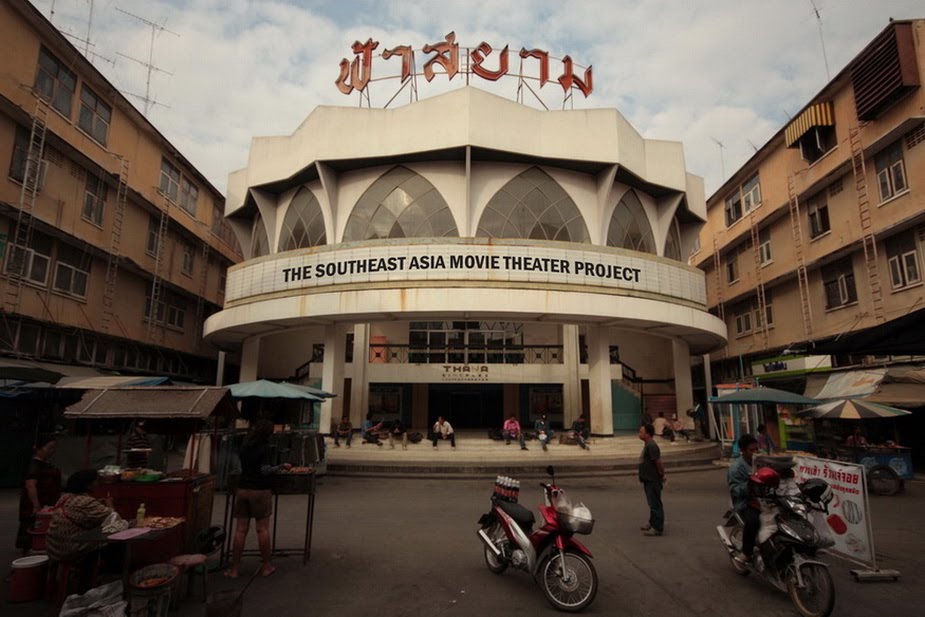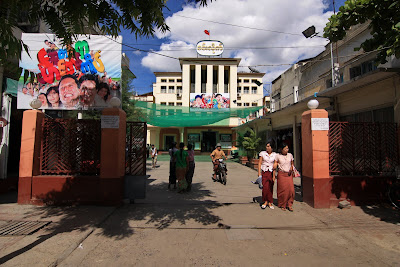It was mid-day by the time my drifting through Mandalay's sun-beaten streets led me to the front steps of the
Nay Pyi Daw Cinema. The relentless heat of Myanmar's second largest city had me sweating like a pig, teetering on brink of collapse. Why hadn't I just payed one the city's thousands of pedicab drivers to chauffeur me there like any normal human would have done?
Looking as if I'd just emerged from a swamp, and probably smelling the part no less, I asked permission of the
Nay Pyi Daw's manager to document this theatrical giant. Permission was granted.
 The Nay Pyi Daw Cinema
The Nay Pyi Daw Cinema:
I should have hitched a ride with that pedicab driver!
If the Win Lite and Myoma represent Mandalay's movie theater elite, with lofty ticket prices to match, then the
Nay Pyi Daw Cinema is the city's blue collar paradise. Located on a small, unpaved alley off of 26th Street in the midst of a largely residential neighborhood, the turquoise-colored cinema hall provides Mandalayans with quality entertainment at a reasonable price.
 A women unloads bags of pork rinds for sale at the Nay Pyi Daw concession stand.
A women unloads bags of pork rinds for sale at the Nay Pyi Daw concession stand.
Built in 1990, the
Nay Pyi Daw Cinema was the second of three government-financed theaters to get built in Mandalay during the 1980's and 90's. All of them share nearly identical, rectangular designs, with massive entrance arches at either end. They were all conceived by the same architect; a woman whose name I was not able to track down.
The newest of Mandalay's state-built theaters, the
Myoma Cinema, featured a few posts back, has the aesthetic distinction of having blue and red tiles covering the exterior walls. Meanwhile, the
Nay Pyi Daw and its elder sibling feature their original plaster and poured concrete facades. Only the paint jobs differ.
The boxy, functional designs found among the three theaters, combined with a caricature-like take on indigenous ornamentation among the older two, seem to have found inspiration from the "Burmese Road to Socialism;" the treatise on economic development that guided national policy from the mid-1960's to the late 80's. If we didn't know better it would be safe to assume that our beloved
Nay Pyi Daw Cinema architect stole the chapter "The Burmese Guide to Socialist Theater Building" for herself. Maybe she even wrote it.
 Plaster relief work along the Nay Pyi Daw's arch
Plaster relief work along the Nay Pyi Daw's arch The rear entrance to the Nay Pyi Daw Cinema is occupied by seamstress's shop called Mi Mi's. The proprietor, Mi Mi - a native of Sittwe - was sewing a dress as I perused the theater grounds. Her husband is the theater's projectionist.
The rear entrance to the Nay Pyi Daw Cinema is occupied by seamstress's shop called Mi Mi's. The proprietor, Mi Mi - a native of Sittwe - was sewing a dress as I perused the theater grounds. Her husband is the theater's projectionist. Mi Mi at work on a dress.
Mi Mi at work on a dress. Kids in theater lobbies these days!
Kids in theater lobbies these days!

Drinking water for patrons at the
Nay Pyi Daw Cinema comes in two forms: the usual bottled form, such as you would find for sale at the concessions stand, and the melted-block-of-ice form, as depicted in the above photo. The latter is dispensed by placing a block of ice in a mesh filter suspended over two plastic cups. The icy run-off percolates through the filter, into the plastic cups below and is then poured into the metal cups seen off to the side. From there they are sold by the cup-full to thirsty customers; the least expensive beverage available. After each customer has quenched their thirst the cups are returned, wiped down and the process begins anew.
Myanmar is the only place I've ever seen this method of providing drinking water and the
Nay Pyi Daw is the only cinema I've ever seen it used in.
 Authentic ice-water, the old fashioned way.
Authentic ice-water, the old fashioned way. The two kids on the right of the above photo enjoy an icy drink courtesy of a block of ice.
The two kids on the right of the above photo enjoy an icy drink courtesy of a block of ice. Tickets, please!
Tickets, please! Nay Pyi Daw staff at repose in the lobby while the movie shows in the auditorium.
Nay Pyi Daw staff at repose in the lobby while the movie shows in the auditorium. Diagonal lobby view
Diagonal lobby view
It was thanks to the hospitality of this man, Mr. Zaw Myint, that I came to learn anything of the
Nay Pyi Daw Cinema. Mr. Zaw Myint has been leasing the
Nay Pyi Daw from the Ministry of Information since it was built in 1990, doing his best to keep it turning a profit despite what he calls "a cold climate" for most movie theaters in Myanmar. "Most Myanmar are simply too poor to go to the movies regularly," he claimed. As a result, movie producers cut budgets to a bare minimum, detracting from the quality of the films they make. Zaw Myint knows this story all too well. In the past he tried his hand at movie production, funding close to a dozen features under the company name of Yi Myint Productions.
When asked about the success of the Mingalar-run theaters in Yangon and Mandalay, he attributed it to their ability to obtain Hollywood and other international films, which wealthier Myanmar will pay higher prices to see. In other words, Mingalar has a monopoly on the good stuff.
Zaw Myint's clientele at the
Nay Pyi Daw, he emphasized, is comprised of poorer members of Mandalay society. The average turn-out is between 50 and 100 patrons per show.
In addition to running the theater, Zaw Myint distributes films throughout central Myanmar.
 Nay Pyi Daw means "capital."
Nay Pyi Daw means "capital."
 The Myo Gon Yaung was the prototype for two later additions to Mandalay's government-built trio of movie theaters. Each of them share nearly identical designs, differing only in the most minute details. All three are the brain children of one architect.
The Myo Gon Yaung was the prototype for two later additions to Mandalay's government-built trio of movie theaters. Each of them share nearly identical designs, differing only in the most minute details. All three are the brain children of one architect. Two destructive, city-wide blazes within a few years of each other speak volumes to the severity of neglect suffered by Myanmar's urban centers. With that in mind, I can only muster a tepid 'hats off' to the powers that be who commissioned the replacement Myo Gon Yaung. Not to detract from this wonder of socialist-inspired cinema architecture. It is, after all, a palace of joy to the entertainment-starved denizens of this, my favorite dust-strewn city in the galaxy.
Two destructive, city-wide blazes within a few years of each other speak volumes to the severity of neglect suffered by Myanmar's urban centers. With that in mind, I can only muster a tepid 'hats off' to the powers that be who commissioned the replacement Myo Gon Yaung. Not to detract from this wonder of socialist-inspired cinema architecture. It is, after all, a palace of joy to the entertainment-starved denizens of this, my favorite dust-strewn city in the galaxy. Showtimes
Showtimes




















































